[ 1-19 ]|[ 20-39 ]|[ 40-59 ]|[ 60-79 ]|[ 80-100 ]
ICEVI Workshop 2002


|

|
| Slide 4. | |

|
|
The number of visually impaired students integrated or included in mainstream education is increasing. Thus the number of classroom teachers, teachers' aids and special teachers who are involved in teaching visually impaired students is also rapidly increasing. During the last ten years multi-impairment has been diagnosed more and more often among the visually impaired infants and children and brain damage has become the most common single cause of visual impairment in western countries. These changes in the nature of visual impairment us to learn more about the visual system and visual functions in visually impaired students.
There are now a great number of families from other cultures more or less permanently in our low vision services. This adds a new aspect to our work: inclusion of their culture into their special education.

There is a great individual variation in the structure of visual impairments. However, in each case the following six main questions should be answered:
- whether the impairment is congenital or acquired,
- how has the general development of the child been and how is its prognosis,
- does the disorder involve the anterior or the posterior visual pathways or both,
- what is known about the visual functions of the child
- does the child use low vision devices; if so, which devices,
- what is the quality of functional vision.
The questions 1 to 5 are answered based on the information given by the child's paeditrician, ophthalmologist, and therapist(s). If the child has or has had a low vision therapist/teacher or orientation and mobility instructor, they can report also on the child's functional vision. Quite often, however, it is a question that the child's classroom teacher, supported by the local special teacher, needs to answer him- or herself.
Since early intervention and special education techniques are based on the type and quality of the child's functional vision, assessment of the child's functioning at school or kindergarten is the most important area to learn. Answers to the other five questions give us important background information and therefore should be clearly written or thoroughly discussed. There is a great variation in the quality of medical services in low vision. In some countries paediatricians, paediatric neurologists and ophthalmologists work together with special education personnel, in other countries medical doctors are so few that they have no time to early intervention or rehabilitation.
Assessment of functional vision is possible based on limited input from doctors if the teachers have some basic tests and have learned to observe visual functioning. This is an area where teleconsultation and distance education could be used more than we use them today.

It is worthwhile to know when the visual impairment has occurred. Congenital or very early disorder often delays motor development and negatively affects early interaction, if the child does not have physiotherapy and the family does not have support and guidance in developing communication with an infant without usual visual communication.
In order to understand how a child now experiences the world, it is important to know what were the developmental milestones in motor development and spatial concepts. These are usually well known by the family and the therapists. It is more difficult to get a description of interaction between the infant/toddler and his/her parents and siblings. Especially, if there have been difficulties in accepting the infant, depression or other problems, these are quite often not reported in the child's documents and rarely reported by the parents during the first meetings. When we learn to know the parents better, it is possible to discuss these delicate questions.
An acquired impairment may occur after normal visual development or a mild impairment becomes more severe at school age. Although the child may not remember how world looked like when (s)he saw it well, the effect of normal or near normal vision is noticeable in motor functions and often also in the content of language. Insidious development of visual impairment as in diffuse retinal degenerations like retinitis pigmentosa often disturbs the child less than acute loss of vision, as in accidents or JNCL (juvenile neuronal ceroid-lipofuscinosis), where other functions are involved as well.
Attitudes of the family and of the child vary from acceptance and knowledge of the structure of the problem to total denial still when a child comes to school. The attitudes of the school will affect the child so they should be assessed as one of the important prerequisites of inclusion.

Development of impaired vision as a part of general development, its effect on development of other functions and other functions' effect on use of vision should be described by persons who have observed the infant/child during the formative years. Since many children have several other impairments or have a progressive disorder, the special education of a visually impaired child with other impairments needs to cover all abilities and disabilities. We build on successes and abilities but need to know hindrances and causes of delays.

This slide lists some of the most common questions to be covered in interviews and in the child's documents.
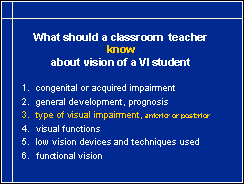
The next question is, whether the disorder, disease or trauma, involves only the anterior part of the visual pathways, or the posterior part or both.
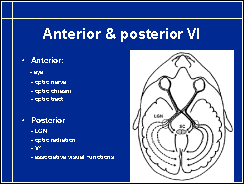
The border between anterior and posterior visual impairment is at lateral geniculate nucleus (LGN). "Anterior" means thus in front of LGN and "posterior" means behind the LGN. The terms "eye disorder/disease" or "optic nerve involvement" or "chiasmal lesion" depict the location of the disorder. Many children with eye disorder also have a posterior visual impairment. For example, many children with retinopathy of prematurity (ROP) also have periventricular leucomalasia (PVL), damage to the nerve fibres passing close to the ventricles.
This picture you know well. There is, however, one feature that might be new to you. There are arrows showing the direction of information flow in the optic radiation both toward the primary visual cortex and from it toward the LGN. Actually, there are more fibres transferring information from the V1 to the LGN than from the LGN to the V1.

This is the picture that I hope you will use several times when you will report to your teams at home. It is so important that I will ask you all to draw it with me. This way you will make it much more understandable to your listeners. Only when you know that important visual information reaches cortical functions bypassing V1, you can appreciate visual functioning of many brain damaged children.
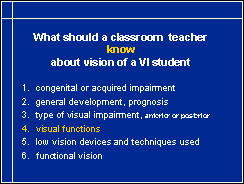
Visual functions that have been examined during clinical investigations should be reported by the child's ophthalmologist. The reports make sense only if the tests are known by the teacher, so the use of the most common vision tests should be a part of introductory teaching of classroom teachers and an important part of the studies of special teachers in vision.
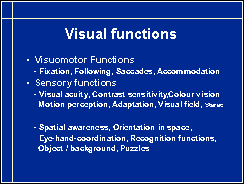
Vision is often discussed as a purely sensory function. However, although it is possible to see without the visuomotor functions, use of vision is very limited without them. Fixation, accommodation and saccades are major problems in many children with visual impairment, especially in children with brain damage or intellectual disabilities. On the third lecture we will see some examples of these functions.
The sensory functions that are evaluated in clinical examinations are visual acuity, contrast sensitivity (not by all consultants), visual field and colour vision. Visual adaptation is easy to measure as time required for Cone Adaptation but it is not regularly performed even in deaf children. Among them, delay of cone adaptation time often is the first clinical symptom of retinal degeneration.
Motion perception is not yet examined in most hospitals and therefore needs to be observed at school or in play situations.
Nowadays we can assess stereovision quite early. It is often not measurable in visually impaired children because their vision has not been good enough so that binocular vision could have developed. Lack of stereovision does NOT mean that the child does not have spatial perception, that (s)he would not see the world in 3 dimensions.
The so called higher visual functions are here as a separate group. There are some 30 visual associative functions, only some of the most important are mentioned here. Actually, all visual sensory functions are higher cortical functions. Also visual acuity, i.e. recognition of optotypes, numbers, letters or paediatric symbols, is one of the several specific recognition functions. In young children, recognition of facial features or recognition of expressions is far more important than recognition of small geometric forms, optotypes.
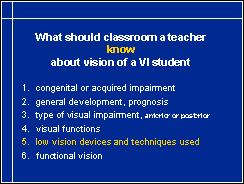
The next question to investigate is the use of optical and nonoptical devices. In this question we need also to know the history of optical correction. Did the infant see well enough without correction or did (s)he get near correction to explore details on the faces of the parents or structure of his/her own body. There are still today numerous visually impaired children who see the fine structure of their hands at the age of 4 years, instead of four months, some still later. Since hands are the second eyes of the visually impaired children they should be made visible from early on.
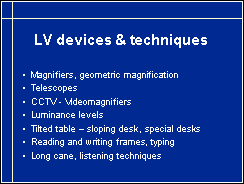
Low vision devices can be used from infancy. The first device is usually overcorrected spectacles, reading glasses, several years before the child can read. Magnifiers and telescopes require fairly good eye-hand coordination so children with motor problems may need to have them fixed on their desk or reading stand or for example, on a window frame to watch birds coming to the bird-feeder.
Videomagnifiers are useful when pictures in picture books cannot be seen using optical magnifiers. This is often the case when a child has poor contrast sensitivity, poor function at low contrast levels.
Need for light varies a lot and should be known. Some children require more than usual amount of illumination, other start to see close to scotopic luminance level, i.e. in very dim light.
At school start the need of using a sloping desk, reading and writing frames, possibly also Braille information and talking books should be assessed and the techniques introduced to the child. Children with multiple disorders may need quite complicated arrangements to meet all their needs. It is quite usual in the western countries that there are more than 15 persons present at the spring meeting at the school beginner's school to plan the first school year starting in August or September. Not only the educational matters need to be covered but the medical experts want to discuss when further operations might least disturb the school year, representatives of the resource centres/ special schools want to know when the child will come for a few days or even two, three weeks for intensive special education and assessment etc.
Special education in all functional areas needs to be covered. Here long cane and listening techniques are mentioned. Also the child's communication and ADL abilities need to be covered.
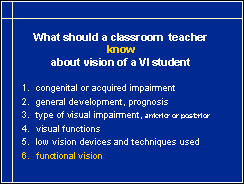
Functional vision is well studied in some places before the child comes to school, in many countries this is the part of information that is lacking and therefore must be covered at school.
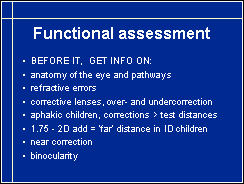
Before starting the assessment you need to check that you have enough clinical information for it. Since you cannot examine the anatomy of the eye and the visual pathways or the refractive errors of the child, this information must be available (in all those countries where medical services function, in other places teachers have to assess these details the best they can; see CD: LEA-Test Website, Assessment, Part I). If the child has glasses, the report should state whether the glasses are under- or overcorrected and if so, why. Aphakic children (= children whose cataracts have been operated) and children who do not accommodate, need to have their reading lenses fitted and the distance where these glasses give the clearest image must be reported. That is the distance where near vision is tested and at which the child will work at school. (If the child wants to hold reading materials much closer than the reported distance then either 1. the child is using geometric magnification and blurred image, i.e. needs stronger reading glasses, or 2. the reading distance has been calculated wrongly, the image is clearest at this shorter distance.)
Children with severe intellectual disabilities and limited cognitive space should have their "distance correction" fitted to allow clear image within their reach, the longer distances are then slightly blurred. These are children who will have one-to-one teaching situation. They usually have their distance correction in their sunglasses because outside they may be interested in observing movement of larger objects at distance.
If near correction and binocularity are not at all mentioned in the child's report, this information is requested from the child's ophthalmologist.
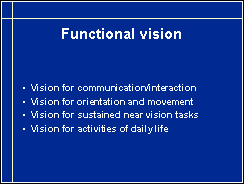
Our assessment of functional vision covers all functional areas: communication, O&M, sustained near vision tasks and ADL. Communication and interaction are the most difficult problem areas in the life of most children with severe visual impairment so our assessment should cover vision for communication in detail.

Since eye contact is important in many cultures (although there are cultures where children are not supposed to have eye contact, except briefly, with their teacher), the type of eye contact is described: is it
- normal, steady eye contact,
- does the child seem to look past the person whom (s)he is looking at because of central scotoma,
- the child cannot fixate gaze or has large angle nystagmus and therefore his eyes do not stop for eye contact.
Next specific ability is to perceive expressions during interactions. With Hiding Heidi test we can assess at which distance the child can see the picture of face at 2.5% contrast. This is usually the maximum distance for seeing expressions on fair or very dark faces.
The distance where the child can perceive the face of an adult person clearly enough to see what the adult person is looking at is also an important distance. Sharing interest with another person is an important part of communication and learning, especially before but also in school age.
Perception of body language is the most important avenue of communication for toddlers and becomes again very important in teen-age because the teenagers often say one thing and the opposite with their body language.
Auditory communication and language skills are next to be assessed. Children can learn to listen for subtle cues of emotional status of other people, breathing, sound of steps etc. Children with dual sensory disabilities need special attention to their communication situations at school, both in the classroom and outside it.
Use of tactile information to support communication is a delicate question because touching is not accepted in all cultures. When allowed, it can be developed to an effective way to convey information on responses of a group to a student with limited communication vision.